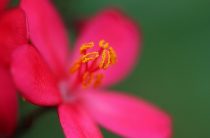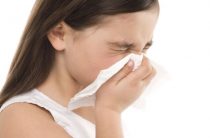A disease such as allergy has become widespread. Allergic reactions are manifested due to the increased sensitivity of the body to external and internal stimuli. This is due to the weak functioning of the human immune system. Protective reactions are violated due to improper functioning of the liver. Particular attention should be paid to children, since early childhood is the most favorable time for the development of any type of allergy.
The most common are such of them: allergy to plant pollen, allergy to animal hair, food allergy, allergy to the sun, allergy to cold. Parents are obliged to carefully monitor all the reactions of their children in order to detect the disease in a timely manner and begin treatment. To do this, it is worth dealing with the first symptoms of this disease.
Symptoms of allergies in children to plant pollen
A very dangerous type of allergy is hay fever. Children have to suffer since the beginning of spring, as the trees are the first to bloom at this time of the year. It all ends at the end of September with the flowering of weeds. Such an allergy in children is characterized by the following symptoms:
- Allergic rhinitis and conjunctivitis;
- Hives;
- Dermatitis;
- Attacks of dry cough;
- Anaphylactic shock;
- Quincke's edema.
As a rule, hay fever in children begins with a severe runny nose or nasal congestion. So if, when you go outside in hot calm weather, you notice rhinitis in your baby, there is a possibility of this disease. Many children often complain of pain in the eyes and lacrimation. This symptom applies to both infants and older children. Ignore these two signs, the baby will also begin to suffer from skin rashes, which bring great discomfort in the form of itching and burning. Combing the wounds on the body in children, ulcers and erosion will begin to form, which over time will lead to scarring. The rash can be both weeping and dry. With peeling and dry rash, it is appropriate to talk about dermatitis. Symptoms such as hives and dermatitis tend to turn into a chronic form that will accompany your baby throughout life. The sites of localization are often the face, arms, legs and back.
Inhaling small particles of pollen, it enters the mucous membrane of the oral cavity, in particular the throat. This leads to violent bouts of coughing. This cough is usually dry and unproductive. Most often, it begins to manifest itself in the evening, it can provoke attacks of suffocation. This symptom is a provocateur of the development of bronchial asthma in children. When allergic to pollen, children often suffer from disorders of the central nervous system in the form of lethargy, fatigue, insomnia, headache. Sometimes there may be loss of appetite and fever.
Quincke's edema is a very dangerous symptom of this disease. It develops in minutes. Often, agnoedema affects such parts of the body as the face, eyelids, limbs, and genitals. Of particular danger is swelling that develops in the oral cavity (tongue, throat, esophagus, larynx, trachea) - it can lead to asphyxiation of your offspring. At the first increase in some parts of the body in size, it is urgent to give your child an antihistamine.
Symptoms of cat allergy in babies
There is an opinion that hairless cat breeds are absolutely hypoallergenic and will not bring any harm to you or your child. This is wrong. After all, allergies do not occur on animal hair, as is commonly believed. A certain protein is produced in the cat's body, which acts as an allergen for a weak human body. It spreads everywhere (furniture, curtains, clothes, dishes) with the help of saliva and urine. Taking care of itself and licking itself, the animal leaves these pathogenic microorganisms on its skin, and upon contact with it, a person begins to experience all the signs of the disease. Therefore, even the absence of wool will not protect your children from the symptoms of this disease.
Some scientists say with certainty that children who have been in contact with a cat since birth suffer from this disease much less often than other babies whose communication with an animal began at the age of two or three.
This is due to the fact that the immune system begins to produce antibodies from the first days of life, and all protective reactions begin their active formation. With an allergy to cats in children, the following first symptoms begin to appear:
- Severe runny nose;
- Attacks of sneezing and coughing;
- Cutting in the eyes;
- Redness of the skin.
All symptoms begin to manifest in children both from the first minutes of contact with the animal, and three to four hours after. This makes children very anxious and irritable. Babies often lose their appetite. The rash on the body manifests itself in the form of small red pimples, which can increase in size over time and form into blisters. It is very difficult for children to control themselves, and they begin to comb these neoplasms, which can serve as a new focus for infection. If you notice such symptoms in your baby, it is best to completely isolate the animal, as well as all its accessories in the form of toys, dishes and a toilet.
Symptoms of food allergies in children
Among all the variety of foods, milk allergy is the most common, especially in infants. Both cow's milk and breast milk can serve as an allergen. The most common symptoms are:
- Nausea;
- Vomit;
- bloating;
- Diarrhea;
- Loss of appetite.
Children due to severe discomfort become irritable and begin to cry often. In such cases, it is imperative to stop giving the baby artificial mixtures, and switch back to breastfeeding. If the child is allergic to breast milk, the mother should go on a strict diet that excludes any dairy and other allergenic products.
In older children, inadequate body reactions to foods happen very often. This is especially noticeable after eating a large amount of sweets and citrus fruits. There comes the so-called diathesis. To the above symptoms, a small red rash is added all over the surface of the body. It is usually localized on the cheeks, arms, palms, buttocks and back of your child. At night, the rash begins to actively itch, which leads to insomnia and other disorders of the nervous system of your child. Often, edema is observed in children with this disease.
Sun allergy symptoms
Such an allergy in children is quite insidious, as it is year-round and constantly brings great discomfort to your offspring. This disease in peanuts manifests itself in the form of the following symptoms:
- Rash on the body;
- Itching and burning of the skin;
- scaly formations;
- abscesses and bleeding;
- Urticaria and eczema;
- Increase in body temperature;
- Loss of consciousness.
All symptoms can appear from the first minutes of staying in the open sun. But, most often, before appearing on the body of a child, an incubation period of two to three hours is maintained. After continuous exposure to ultraviolet light, the first redness in the form of burns is observed on the child's body. If during the day they do not go out, then we can safely talk about photodermatosis. It is categorically contraindicated for peanuts with such a disease to sunbathe, and they can take sunbaths only in the shade.
All wounds bake very strongly, which prevents the baby from leading a normal life. When the wounds begin to heal, the children experience severe itching and, when scratched, bleeding begins again. Which creates a kind of vicious circle. In severe cases, the body temperature rises in children, and loss of consciousness occurs. In infants with a disease such as photodermatosis, there is always a sharp appearance of urticaria, and not only under the influence of sunlight, but simply at high air temperatures.
Cold allergy symptoms in children
After a long stay in the cold, some children may experience an allergic reaction of the body. Such an allergy in children occurs as a result of a violation of heat exchange with the environment and the body of your child. This disease is especially susceptible to children with disorders in the work of the heart. This type of allergy cannot be attributed to a seasonal disease, since patients suffer all year round from the influence of cold water in the house or reservoirs. Symptoms in children are as follows:
- Cold urticaria;
- Runny nose;
- Conjunctivitis;
- Cold dermatitis;
- peeling of the skin surface;
- Roughness of the skin around the lips and eyes.
Such manifestations as pain in the eyes and lacrimation usually appear after being in the cold - by going into a warm room. Often, all symptoms are accompanied by breathing difficulties. It is very difficult for children to inhale cold air, they begin to have asthma attacks. All this affects the functioning of the central nervous system.
Symptoms of dust allergy in children
This disease is very common among children, and in no case should it be left unattended, since everything can lead to a very serious disease - bronchial asthma. Symptoms in children are as follows:
- Skin rash;
- Wheezing in the voice;
- Cough;
- Nasal congestion;
- Dermatitis.
Such signs are characteristic of many newborn babies. Therefore, it is very important that the bedding of babies is sterile clean, and with the advent of the child, be sure to install a humidifier in the room. A large amount of household dust accumulates on books and other interior items. Due to contact with all these things, the baby begins coughing fits, mainly at night. Dermatitis manifests itself mainly on the hands, since this area of \u200b\u200bthe body is the most unprotected. It is very important to maintain perfect cleanliness in the house and carry out daily wet cleaning. Soft toys, carpets and thick curtains, which are real dust collectors, are of great danger. It is better to get rid of all these items.
We advise you to read:















